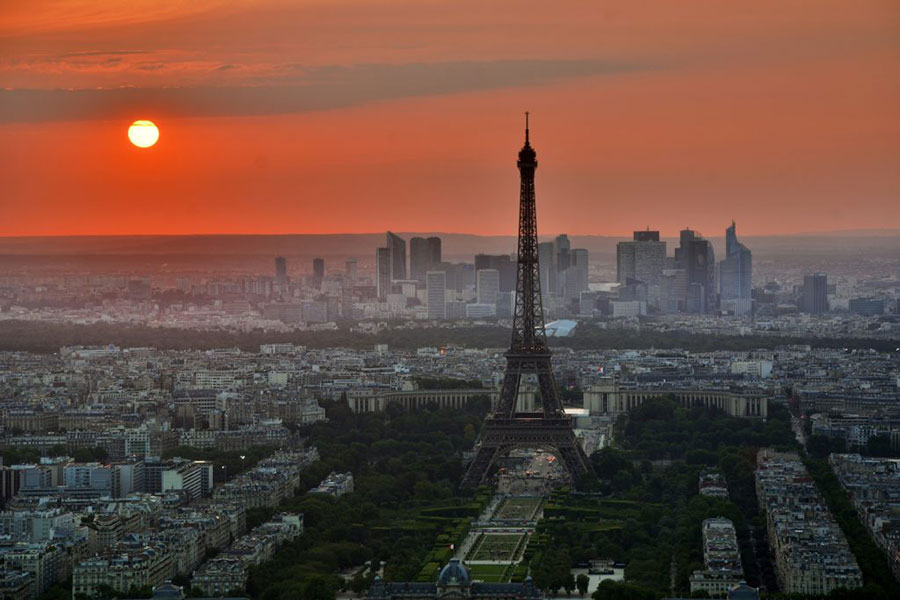Week 1 | Week 2 | Week 3 | Week 4 | Week 5
1.6

Eiffel tower, Paris, France.
Climate change impacts and vulnerabilities
In this part, we’ll explore climate change impacts, climate targets, and assess the Paris Agreement from 2015. In a moment, we’ll hear more on the Paris Agreement and climate targets from Zennström climate change leadership professors Kevin Anderson and Doreen Stabinsky. But first, let’s review some background on climate change trends and impacts.
Global warming, predominantly caused by the burning of fossil fuels, has already led to an estimated increase of average global temperatures by 1.07°C since 1850. Carbon dioxide concentrations in the atmosphere are (at 410ppm) at the highest level in 1 million years. [1]
In the Paris Agreement, world leaders have agreed to limit the rise in global temperatures to 2°C or even 1.5°C above preindustrial levels. [2] However, both current business-as-usual emission trends and the emission pledges that were brought by countries to the Paris meeting, are on track to seriously overshoot that goal.
The Intergovernmental Panel on Climate Change (IPCC) has developed a number of “representative concentration pathways” (RCP) which see greenhouse gas concentrations stabilising at different levels. RCP 2.6 is a relatively low-emission pathway, supposed to give a 66% chance to limit the rise of global mean temperature to 2°C. RCP 8.5 represents a high-emission pathway, leading to temperature rises of 4°C or more. [3]
What does this mean in practice? The first thing to note is that some areas, such as the Arctic and the Himalayas, are warming much faster than others. This means that a certain increase of global mean temperature may lead to much higher temperature increases in certain regions, such as the Arctic and the Himalayas, compared to others. [4] Secondly, the vulnerability and the ability to adapt to climate change is uneven across the globe. Therefore particularly vulnerable and predominantly poor communities in the global South, that have contributed the least to climate change, will face an unproportionally large burden from climate change. [5]
Even relative small rises of the global mean temperature may lead to significant risks. The IPCC was formed in 1988 to “provide the world with a clear scientific view on the current state of knowledge in climate change and its potential environmental and socio-economic impacts”. [6] The Fifth Assessment Report, published in 2014, made clear that even balancing global warming to 2°C above pre-industrial levels will lead to significant risks, including increased risks from extreme weather events and threats to unique ecosystems and cultures. [7] The Sixth Assessment Report is now released, read more here AR6 Synthesis Report: Climate Change 2023.
The planet has historically buffered human impact on the climate (for example, oceans have been absorbing 90% of the added heat until now). [8] But scientists are worried that, as we approach tipping points in the system, the planet may start to reinforce human impact instead. This may lead to uncontrollable climate change, which it will be impossible to adapt to.
The kind of future that we create will, as we will discuss the coming weeks of this course, depend on the choices that we make the upcoming years and decades.
References
- IPCC (2021). Climate Change 2021: the Physical Science Basis. Working Group I Contribution to the IPCC Sixth Assessment Report. Geneva: IPCC.
- United Nations Framework Convention on Climate Change, UNFCCC (2015). The Paris Agreement
- IPCC (2013). Summary for Policymakers. In: Climate Change 2013: The Physical Science Basis. Contribution of Working Group I to the Fifth Assessment Report of the Intergovernmental Panel on Climate Change. Cambridge & New York: Cambridge University Press, p. 19
- IPCC (2014). Summary for Policymakers. In: Climate Change 2014: Synthesis Report. Contribution of Working Groups I, II and III to the Fifth Assessment Report of the Intergovernmental Panel on Climate Change. Geneva: IPCC, p. 12
- IPCC (2014). Summary for policymakers. In: Climate Change 2014: Impacts, Adaptation, and Vulnerability. Contribution of Working Group II to the Fifth Assessment Report of the Intergovernmental Panel on Climate Change. Cambridge & New York: Cambridge University Press, p. 6
- Website of the Intergovernmental Panel on Climate Change
- IPCC (2014). Summary for policymakers. In: Climate Change 2014: Impacts, Adaptation, and Vulnerability. Contribution of Working Group II to the Fifth Assessment Report of the Intergovernmental Panel on Climate Change. Cambridge & New York: Cambridge University Press, p. 13
- IPCC (2013). Summary for Policymakers. In: Climate Change 2013: The Physical Science Basis. Contribution of Working Group I to the Fifth Assessment Report of the Intergovernmental Panel on Climate Change. Cambridge & New York: Cambridge University Press, p. 8
© CEMUS and Uppsala University
